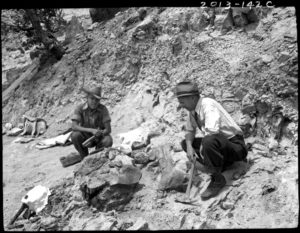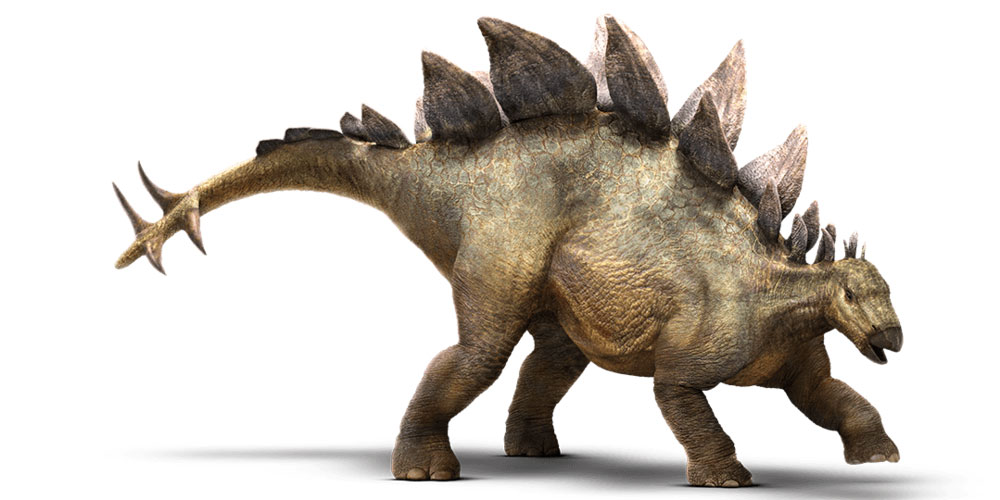By Virginia McConnell Simmons
Meet Stegosaurus stenops, Colorado’s state fossil. The local popularity of dinosaurs is evident at Cañon City, where prison inmates created a large model of a Stegosaurus several years ago. It became a familiar mascot, once seen on the east side of town and later moved to the Fremont Campus of Pueblo Community College. Nearby on Skyline Drive, dinosaur tracks also can be viewed by visitors, and only a few miles, at Garden Park our state fossil was unearthed nearly intact.
Once upon a time, not far from Cañon City, this strange beast, looking something like a huge lizard nearly 30 feet long, lumbered around on two legs, munching on lush plants. It had large, hard scales on its back that protected it from being bitten and killed by other weird-looking creatures. On one end, it had a long tail that could be whipped around to smack anything that came too near, and on the other end it had a brain about the size of a walnut, so this creature was not very smart and really needed those scales and that tail for protection. For comparison, Tyrannosaurus rex, found in many children’s toy boxes, was even larger than Stegosaurus.
Stegosaurus was one of the Late Jurassic dinosaurs that roamed throughout our planet Earth more than 200 million years ago. In Colorado, these reptiles left their tracks and bones in sedimentary rocks at Garden Park, Skyline Drive, Red Rocks near Morrison, Dinosaur National Monument, Picketwire, Canyonlands, and several other locations.

The individual who first recognized fossils in Garden Park was a homesteader, Marshal P. Felch. He was a Civil War veteran who arrived from Massachusetts with his family during the winter of 1869-1870 and set about plowing ground for crops in the gulch of Fourmile Creek that spring. On an outcrop of sedimentary rock above the gulch, he noticed crumbly fossils.
At that time, fossils in the still-new American West were attracting attention. Scientific expeditions, like George Montague Wheeler’s and Ferdinand Vandeveer Hayden’s, included geologists, and museums like the Peabody at Yale and the American Museum of Natural History in New York City were jealously competing to acquire paleontological material for their collections, during what was called “the Bone Wars.” One of these men who accompanied some surveys was Othniel Charles Marsh, who happened to be the well-connected nephew of the Peabody Museum at Yale’s namesake. By the mid-1870s, scientists at the Colorado School of Mines also had become interested in the fossils in the Morrison Formation of sedimentary red rock near Golden and Morrison, Colorado, where Stegosaurus bone was found in 1876.
Meanwhile, farmer Marshall Felch had begun digging off and on in what was called the Felch Quarry. By the early 1880s, Felch had written to Othniel Marsh, who responded that he was, indeed, interested and sent some of his crew to investigate. The upshot was that Felch and some of Marsh’s field workers operated at the quarry until 1888 at what became called the Marsh Quarry. Small outbuildings were constructed at the workings, and tons of material were crated and shipped to Yale in New Haven from Cañon City on the Denver & Rio Grande Railroad during that period. Felch was paid by Marsh for his work, while Felch hired help to operate the farm. A vandal caused the destruction of some property, but a teacher, Frederick Carl Kessler and his students at Cañon City High School, later visiting the quarry, fortunately discovered the nearly complete Stegosaurus skeleton that became the state fossil and awes visitors in the Denver Museum of Science and Nature today.
[InContentAdTwo]
The Garden Park Fossil Area is about six miles north of Cañon City on 9 Road. Managed by the Royal Gorge Field Office of the Bureau of Land Management (BLM), the site offers trails and interpretive displays and is registered as a National Natural Landmark. Garden Park is well worth the short drive to visit this scenic and informative area.
Virginia McConnell Simmons, who recently celebrated her 90th birthday, has been the author of hundreds of articles and more than a dozen books about the West, including The Upper Arkansas: A Mountain River Valley.




It is my understanding that the man in the picture on the left is Robert Landberg. He is in about seven photographs in their photo archives. This is a quote from the DMNS annual report for 1937 “Through the further cooperation of Mr. Kessler, permission to excavate was obtained from the Diamond Fire Brick Company, owners of the site, and Mr. R. Nelson who holds grazing rights. Early in the summer, Robert Landberg, Assistant Preparateur, began the work of removing the bone”